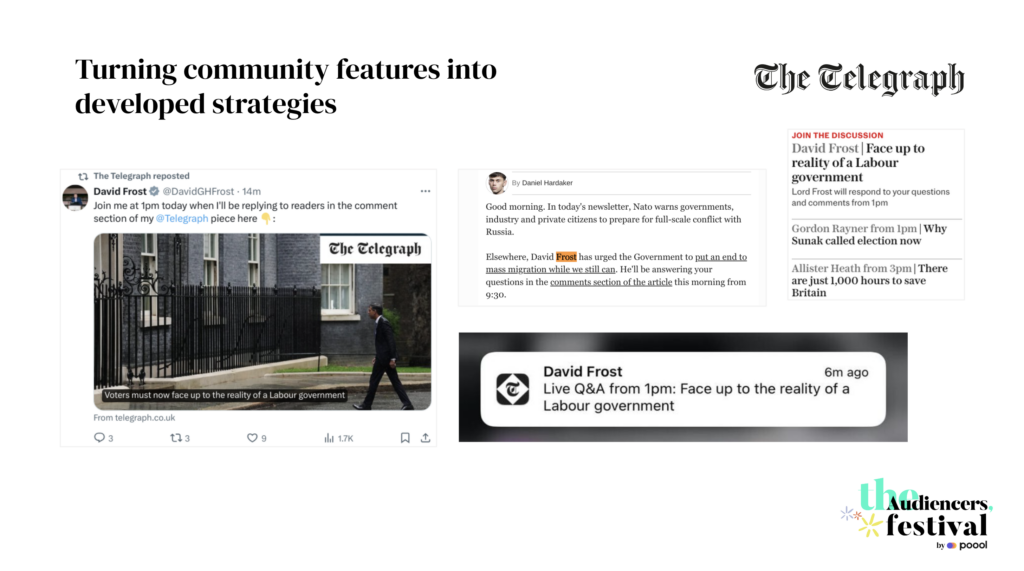Developing community beyond commenting, with The Telegraph and The Times

For our second event in London, The Audiencers' Festival on June 21st dived into the digital reader revenue models of publishers from no fewer than 7 countries around the world, sharing their solutions to some of the challenges being faced across the industry.
One key trend that we couldn't leave out of the day's sessions was community building, an essential strategy to build an engaged audience who find a sense of belonging with your products and brand. And community goes way beyond simply forums and commenting, as we found out in this panel!
Discussing the topic:
- William Whittington, Lead Community Moderator at The Telegraph
- Birger Soiland, VP Sales at Norkon
- Peter Jackson, Reader Comment Editor at The Times and Sunday Times
Turning community features into developed strategies at The Telegraph
Will is Lead Community Moderator at The Telegraph, managing a 6-person team, leading on their community and moderation strategy.
“Commenting is subscriber-only, and whilst it's only one of the functions that we use to engage our audience, it's maybe the foundation of our community model, using this to get readers involved in our journalism.
For instance, since the beginning of this year we've been working closely with our editorial team to get writers involved in the comments section, interacting with our audience. It's one of the strategies that's been the most effective in getting readers engaged. We've seen a 119% increase in the number of comments that are posted once an author has ‘gone below the line' (i.e. joined the comments section).”
For example, journalists such as David Frost go into the comments section at a specific time each week. This is marketed on social media, on the homepage and app (including push notifications) to encourage readers to get involved.

Best practices that have made this strategy so effective:
- Signposting the fact that a journalist is ‘going below the line' across all platforms, with a specific time for readers to join
- Being able to pin comments to highlight them to readers
- Have a badge to verify journalists so readers know to trust them
- Highlight the best questions and answers with a particle, making readers feel recognized and valued

“Getting journalists involved has helped us show the value of an engaged community to our business model. In turn, this ensures the comments section is not only active but contributing to our journalism.”
Best practice: share the success of your community with the whole organization to bring teams onboard and get them involved in engaging with your readers.
> To read next: From community to reader revenue: lessons to learn from The Independent and Reach PLC
Engaging in different ways
Polling is a way of getting immediate responses from audiences, on-site, in newsletters and on socials. And articles can be produced off the back of these.
“One of the polls following an election debate received 95,000 responses, one of the highest voting numbers ever seen, so much so that Nigel Farage shared it on socials!”
They also have weekly Q&As where readers submit their questions, published in a variety of formats: articles and live.

Gamification for community engagement
Birger joined the discussion from a gamification perspective, sharing how this format can be valuable for community development and activation at all steps in the funnel.
- Acquiring new audiences, including younger readers. For example, one of the publishers working with Norkon found that 40% of players are between 18-35 years old, including more females than their average readership
- Games and competitiveness brings readers back to your site again and again, plus these games can be connected to other engagement formats such as commenting or live blogging so users can communicate with other players and feel part of a community. Articles can also be tied to games to loop back to your journalism
- Integrating conversion steps into games to get more value from these readers. For instance a simple registration wall to ask readers to create a free account in order to continue playing, save their progress and chat with other users


> Dive deeper: How DN leveraged gamification to attract a younger audience, and got almost 35,000 new registered users
Birger also spoke to the value of gamification for advertising revenue. For instance by having sponsors for a live Q&A or game, providing the prize to winning participants.
Reader-led journalism at The Times and Sunday Times
Peter is the Reader Comment Editor at The Times, with a team of 8 Reader Comment Journalists working to increase engagement through community. Whilst the team do moderate comments, they do a whole lot more than that!
“Reader-led articles give a direct voice to our readers, but it also improves our journalism! The piece on the right below came from a call-out at the bottom of an article that got an amazing response from people telling us about how they beat their diagnoses. We ran it as a story and it really humanized the journalism. The other piece came from the simple idea of asking why people were running the London marathon. It pulled very touching stories together, and you could see in the comments section how positive the reaction was. These reader-led articles often bring yet more valued conversation within the community.”

It's about community members not only seeing other community members as individuals and hearing their stories, but also allowing each reader to imagine themselves in this context, connecting with the brand in a much more human way.
Live Q&A
Live Q&As are another important engagement tool to directly connect The Time's readers and writers.
“For instance, before the Euros kicked off, we had a dedicated hour where our experts answered questions and offered color on the topic. The quality of the conversation is so high in these cases because our readers have an invested interest. They've come to the experience ready to engage and participate. These 1-to-1 conversations with top journalists that subscribers get access to is incredibly valued.”

Like The Telegraph, The Times also works with polls and elbedded carousels to elevate comments, but they also feature reader contributions in their journalism, such as “Reader's recipe”. Peter highlights how this has a positive impact on the brand, showing how The Times values its readers.

Reducing toxicity
Back in 2022, The Times worked on a project to reduce toxicity by reducing anonymity in their comments section. The idea: “people should know who they're speaking to if you want a high quality conversation.”
At the time, only 37% of commenters were using their real name, today they're at an impressive 98%.
“It was a long process involving many different departments at The Times, and lots of communication around it. Subscribers were told early on that they needed to use their real name, and there was a 3-step process to do this. But since making the change we've seen toxicity come down – it's a safer, more welcoming community, and attacks on writers was down 25% – and an increase in the number of comments. People who don't use a real name stick out for a bad reason – they're now blocked and then become compliant.“

“Our top commenters – not necessarily in quantity but in how their comments are received, liked and replied to – were invited to visit the newsroom, meet our editors and spend the day with us, as a way of saying thank you. We turned this into a piece for the site, allowing other commenters to see how we take community seriously.”
Thank you so much to our panelists for being part of The Audiencers' Festival!

